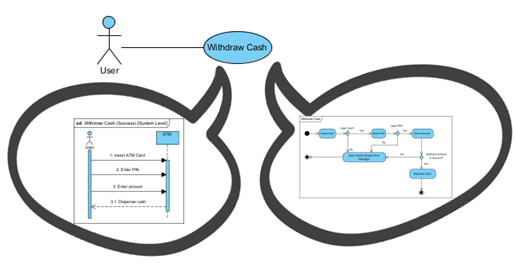Choosing the Right Diagram: Sequence or Activity for Use Case Elaboration
Introduction
In the realm of software development, the choice of diagrammatic representation plays a pivotal role in effectively communicating the intricacies of a system. When it comes to elaborating use cases, the decision between employing a sequence diagram or an activity diagram can significantly impact the clarity and understanding of the intended processes. This discussion delves into the strengths of each diagram type, considering their applications and nuances. By understanding the distinctive features of sequence and activity diagrams, we aim to guide the selection process based on the specific requirements of the use case at hand.
Sequence Diagrams or Activity Diagram?
The choice between using a sequence diagram or an activity diagram depends on the nature of the use case and what aspects you want to emphasize.

- Strengths: Ideal for representing the interactions between different objects or components in a specific scenario. It illustrates the flow of messages or interactions between these entities over time.
- Use Cases: Great for scenarios where the chronological order of events is crucial, and you want to highlight the dynamic aspects of the system.
- Strengths: Useful for capturing the overall flow of activities in a system. It provides a higher-level view of the workflow and is excellent for showcasing parallel or concurrent activities.
- Use Cases: Well-suited for scenarios where you want to emphasize the flow of activities, decisions, and the overall structure of the system.
Choosing Between Them:
- Complexity of Interactions: If your use case involves complex interactions between different entities with a focus on the chronological order of events, a sequence diagram might be more appropriate.
- Process Flow: If the use case involves multiple activities, decisions, and parallel processing, an activity diagram can provide a clearer overview of the overall flow.
- Level of Detail: Consider the level of detail you want to convey. Sequence diagrams are more detailed and specific to interactions, while activity diagrams are more abstract and focus on high-level processes.
- Communication Needs: Think about your audience. If you are communicating with developers who need to understand detailed interactions, a sequence diagram might be more effective. If you are discussing the system with non-technical stakeholders, an activity diagram could offer a more accessible representation.
There’s no one-size-fits-all answer. Both sequence diagrams and activity diagrams serve different purposes, and the choice depends on what aspects of the system you want to emphasize in your use case. It’s also common to use both diagrams in conjunction, with each highlighting different aspects of the system.
Summary
The decision between sequence and activity diagrams hinges on the nature of the use case and the emphasis on either detailed interactions or overarching processes. Sequence diagrams shine in depicting chronological order and interactions between entities, providing a granular view. On the other hand, activity diagrams excel at illustrating the overall flow of activities, making them suitable for scenarios with parallel processes and high-level structural insights. The choice ultimately depends on factors such as complexity, the level of detail needed, and the target audience. Often, a judicious combination of both sequence and activity diagrams proves to be the most effective approach for comprehensive use case elaboration.

